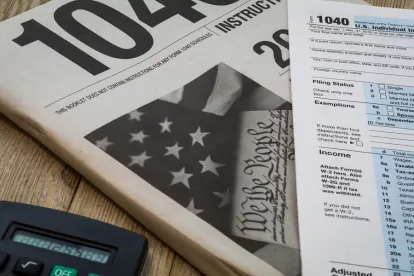Summary
Section 163(j), as recently amended, may limit a taxpayer’s interest expense deduction. Notice 2018-28, in very general terms, provides interim guidance on the application of Section 163(j).
Importantly, the Notice confirms that (1) a taxpayer with disallowed interest expense from taxable years prior to January 1, 2018 may carry forward such interest expense to the taxpayer’s first taxable year after December 31, 2017; (2) Section 163(j) applies at the consolidated group level; (3) Section 163(j) will not impact whether or when business interest expense reduces a corporation’s earnings and profits; and (4) taxpayers cannot “double count” business interest income earned through a partnership or S Corporation.
In Depth
On April 2, 2018, the Department of Treasury (Treasury) and the Internal Revenue Service (IRS) released Notice 2018-28 (Notice). The Notice provides very helpful guidance to taxpayers complying with new limitations on the deductibility of business interest expense under Section 163(j). Treasury and the IRS intend to issue proposed regulations under Section 163(j) and the Notice describes certain of the rules that the proposed regulations will include to provide taxpayers with interim guidance as more comprehensive guidance is developed.
Prior to the tax legislation commonly referred to as the Tax Cuts and Jobs Act (Act), Section 163(j) disallowed a deduction for disqualified interest paid or accrued by a corporation if two threshold tests were met. The first test was satisfied if the corporate taxpayer’s debt-to-equity ratio exceeded 1.5 to 1.0. The second test was satisfied if the corporate taxpayer’s net interest expense (the amount by which all interest expense paid or accrued during the taxable year exceeds the amount of interest income includible by the taxpayer in gross income for such taxable year) exceeded 50 percent of its adjusted gross income (in general, taxable income computed without regard to deductions for net interest expense, NOLs, Section 199 domestic production activities, depreciation, amortization and depletion). For this purpose, disqualified interest included interest paid or accrued to foreign related parties when no federal tax was imposed on such interest, interest paid or accrued to unrelated persons if a related party guaranteed the debt (and certain other requirements were met), and interest paid or accrued by a taxable REIT subsidiary to a REIT. Interest expense disallowed under ‘old’ Section 163(j) was treated as paid or accrued in the succeeding taxable year and could be carried forward indefinitely. Any excess limitation (the excess, if any, of 50 percent of the corporation’s adjusted taxable income over its net interest expense) could be carried forward for three years. Under ‘old’ Section 163(j), proposed regulations contained a ‘super affiliation’ rule that treated all members of an affiliated group as one taxpayer for Section 163(j) purposes without regard to whether the affiliated group filed (or could file) a consolidated return.
As amended by the Act, Section 163(j) limits a taxpayer’s annual deduction for business interest expense to the sum of the taxpayer’s business interest income, and 30 percent of the taxpayer’s adjusted taxable income (ATI). Business interest expense means any interest paid or accrued on indebtedness allocated to a trade or business and business interest income means any interest includible in the gross income of the taxpayer which is properly allocated to a trade or business. Accordingly, investment interest income and expense is outside the scope of Section 163(j). ATI means the taxable income of the taxpayer computed without regard to (1) any item of income, gain, deduction or loss which is not properly allocated to a trade or business, (2) any business interest expense or business interest income, (3) any NOL deduction under Section 172, (4) any deduction allowable under Section 199A, (5) for taxable years beginning before January 1, 2022, any deduction allowable for depreciation, amortization or depletion.
Section 163(j) applies to all taxpayers, not just corporations. There are exceptions for taxpayers with average gross receipts for the three prior taxable years of $25 million or less and certain trades or businesses (generally, electing real property businesses, electing farming businesses, utilities, employees and floor plan financing). Any business interest expense that is not allowed as a deduction may be carried forward indefinitely. There is no carry forward for any excess limitation.
There is a complicated rule for partnerships. Section 163(j) as amended applies at the partnership level and any deduction for business interest expense is taken into account in determining the partnership’s non-separately stated taxable income or loss. Each partner’s ATI is (1) determined without regard to such partner’s distributive share of any item of income, gain, deduction or loss of the partnership and (2) increased by such partner’s distributive share of the partnership’s excess taxable income (ETI). ETI means, with respect to any partnership, the amount which bears the same ratio of the partnership’s ATI as the excess, if any, of (1) 30 percent of the partnership’s ATI for the taxable year, over (2) the amount, if any, by which the partnership’s business interest expense exceeds the partnership’s business interest income, bears to 30 percent of the partnership’s ATI for the taxable year.
Any excess business interest expense that is not allowed as a deduction to the partnership is not carried forward to the succeeding taxable year. Instead, it is allocated to each partner in the same manner as the partnership’s non-separately stated taxable income or loss. If a partner is allocated any excess business interest expense for the taxable year, such excess business interest expense is treated as business interest expense paid or accrued by the partner in the next succeeding taxable year in which the partner is allocated ETI from the partnership, but only to the extent of such ETI (the ETI limitation). The portion of any excess business interest expense remaining after applying the ETI limitation is treated as business interest expense paid or accrued in succeeding taxable years. Once all of such business interest expense for all preceding years has been treated as paid or accrued by a partner as a result of allocations of ETI to such partner, any remaining ETI that has been allocated to a partner will be taken into account when computing the partner’s own Section 163(j) limitation with respect to any business interest expense the partner has incurred at the partner level.
Any excess business interest expense that is allocated to a partner reduces (but not below zero) such partner’s adjusted basis in its partnership interest. If a partner disposes of a partnership interest, the adjusted basis of the partner in the partnership interest is increased immediately before the disposition by the amount of the excess (if any) of the amount of such basis reduction over the portion of any business interest expense allocated to the partner which has previously been treated as business interest expense paid or accrued by the partner.
Market participants had identified several issues regarding the application of Section 163(j) that required clarification. The Notice addresses many of these important issues in a manner that is helpful for taxpayers.
There was some concern that C corporations would have to allocate interest income and expense between business activities and investment activities. The Notice states that Treasury and the IRS intend to issue regulations clarifying that, solely for Section 163(j) purposes, all interest income includible in gross income by a C corporation will be business interest income and all interest paid or accrued by a C corporation will be business interest expense. Such regulations will not apply to S corporations, but the regulations will address interest income and expense allocated to a C corporation that owns a partnership interest.
In addition, as discussed above, the proposed regulations issued under ‘old’ Section 163(j) contained a super affiliation rule that treated all members of an affiliated group as one taxpayer for Section 163(j) purposes without regard to whether the affiliated group filed (or could file) a consolidated return. The Act eliminated the statutory provisions that treated an affiliated group as one taxpayer and permitting the super-affiliation rules. Treasury and the IRS, according to the Notice, intend to issue regulations that Section 163(j) applies on the consolidated group level. An affiliated group that does not file a consolidated return will not be treated as one taxpayer. The regulations will address, among other things, the allocation of the Section 163(j) limitation among group members, and the treatment of disallowed interest deduction carryforwards when a member leaves the group.
The Act did not address the treatment of disqualified interest expense disallowed under Section 163(j) prior to the Act. Treasury and the IRS intend to address that issue by issuing regulations clarifying that taxpayers with disqualified interest disallowed under ‘old’ Section 163(j) may carry forward such interest to the taxpayer’s first taxable year beginning after December 31, 2017. Any business interest carried forward will be subject to potential disallowance under Section 163(j), as amended by the Act and will be subject to Section 59A (BEAT). In addition, the regulations will contain rules for allocating business interest expense from a super-affiliated group under the ‘old’ Section 163(j) proposed regulations.
The Notice also states that regulations will clarify that the disallowance and carryforward of a deduction for a C corporation’s business interest expense under Section 163(j) will not affect whether or when such business interest expense reduces earnings and profits of the payor C corporation.
Section 163(j) requires that the business interest expense limitation be applied at the partnership level and that the business interest expense be taken account in determining the partnership’s non-separately stated income. The Treasury and the IRS intend to issue regulations providing that, in general, for purposes of calculating a partner’s annual business interest expense deduction, a partner cannot include its share of the partnership’s business interest income for the taxable year except to the extent of the partner’s share of the excess of (1) the partnership’s business interest income over (2) the partnership’s business interest expense. Such regulations are intended to prevent a partner from “double counting” business interest income earned through a partnership for Section 163(j) purposes. Similar rules will apply to S corporations and their shareholders. A partner’s adjusted basis in its partnership interest is relevant to many common transactions between a partnership and its partners. For example, distributions in excess of basis are taxable under Section 731, including deemed distributions on repayment of partnership debt. In addition, allocations of partnership loss are allowed only to the extent of the partner’s basis in its interest. The basis adjustments required under Section 163(j) will need to be considered prior to a distribution or loss allocation to avoid an unintended tax consequence.
In conclusion, the Notice addresses several important issues in a manner that is generally favorable to taxpayers. Treasury and the IRS have asked for (and have received) comments regarding the application of Section 163(j). We expect additional guidance on this important subject sometime later this calendar year.






 />i
/>i

